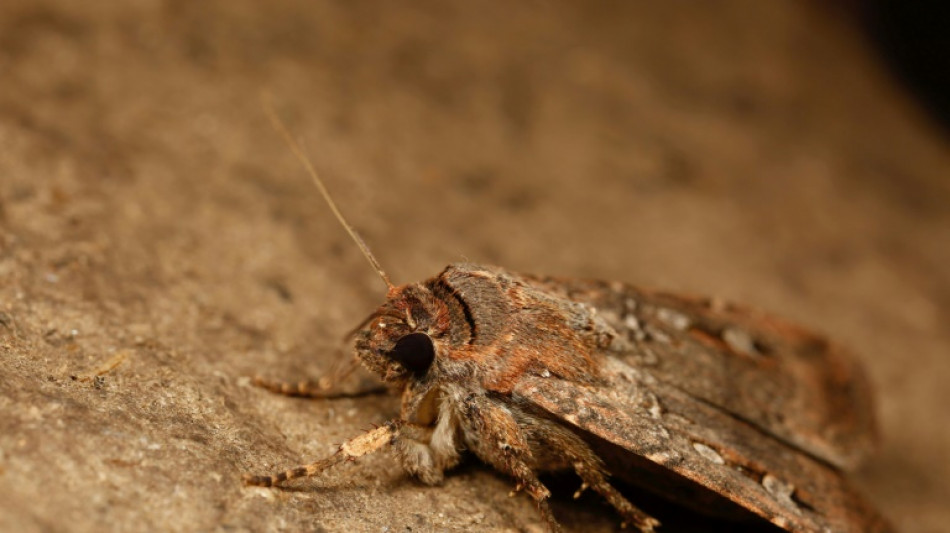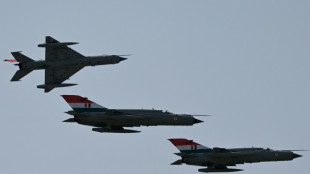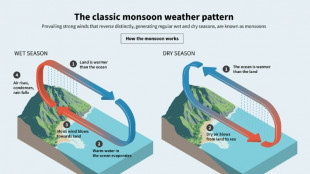
-
 Canada's Patrick Watson channels dread into new 'Uh Oh' album
Canada's Patrick Watson channels dread into new 'Uh Oh' album
-
Trump brands indicted opponent Comey a 'dirty cop'

-
 Walker an all-time great, says Guardiola ahead of Man City return
Walker an all-time great, says Guardiola ahead of Man City return
-
Alonso warns against overconfidence before Madrid derby

-
 Fritz says path to Grand Slam glory goes through Alcaraz, Sinner
Fritz says path to Grand Slam glory goes through Alcaraz, Sinner
-
UK court drops terror case against Kneecap rapper

-
 UK's Starmer urges liberals to fight 'the lies' told by far right
UK's Starmer urges liberals to fight 'the lies' told by far right
-
Bagnaia and Pennetta among first Winter Olympic torch carriers: organisers

-
 Sarkozy conviction exposes political divide in crisis-hit France
Sarkozy conviction exposes political divide in crisis-hit France
-
Ryder Cup begins in electric atmosphere at Bethpage Black

-
 UK to launch digital ID scheme to curb illegal migration
UK to launch digital ID scheme to curb illegal migration
-
Chelsea's Palmer sidelined with groin injury

-
 India retires Soviet fighter jet after six decades
India retires Soviet fighter jet after six decades
-
Slovak parliament approves anti-LGBTQ constitutional change

-
 Train tragedy hunger striker captures hearts in Greece
Train tragedy hunger striker captures hearts in Greece
-
I.Coast historic beachside town boasts new modern art museum

-
 PSG captain Marquinhos out with thigh injury
PSG captain Marquinhos out with thigh injury
-
UK court drops terror charge against Kneecap rapper

-
 Turkish Airlines inks big Boeing deal after Erdogan visits US
Turkish Airlines inks big Boeing deal after Erdogan visits US
-
Liverpool's Leoni faces year out after ACL injury on debut

-
 'We are not afraid,' jailed Istanbul mayor tells court
'We are not afraid,' jailed Istanbul mayor tells court
-
Canada's women tilt for World Cup thanks to 'incredible' crowdfunding

-
 India retires 'flying coffin' Soviet fighter jet after six decades
India retires 'flying coffin' Soviet fighter jet after six decades
-
Erasmus makes late Springboks change as Nche injured

-
 Ukrainian YouTuber arrested in Japan over Fukushima livestream
Ukrainian YouTuber arrested in Japan over Fukushima livestream
-
Foreign doctors in Gaza describe worst wounds 'they've ever seen'

-
 India-Pakistan to clash in first Asia Cup final
India-Pakistan to clash in first Asia Cup final
-
South Asia monsoon: climate change's dangerous impact on lifeline rains

-
 Million-year-old skull could change human evolution timeline
Million-year-old skull could change human evolution timeline
-
Gauff launches China Open title defence in style

-
 Netanyahu set for defiant UN speech as Trump warns on annexation
Netanyahu set for defiant UN speech as Trump warns on annexation
-
The world's last linen beetling mill eyes strong future

-
 Iran sanctions look set to return after last-ditch UN vote
Iran sanctions look set to return after last-ditch UN vote
-
Poland cools on Ukrainians despite their economic success

-
 Canada signs free trade agreement with Indonesia
Canada signs free trade agreement with Indonesia
-
Danish airport closes again after suspected new drone sighting

-
 Cheap moonshine kills 11 in Colombia
Cheap moonshine kills 11 in Colombia
-
Quake-hit Myanmar city becomes epicentre of junta election offensive

-
 400,000 evacuated, 3 dead as fresh storm batters Philippines
400,000 evacuated, 3 dead as fresh storm batters Philippines
-
In India's Mumbai, the largest slum in Asia is for sale

-
 Red-hot Liverpool face Palace test as Arsenal try to keep pace
Red-hot Liverpool face Palace test as Arsenal try to keep pace
-
Israeli strikes kill 9 in Yemen's rebel-held capital: Huthis

-
 Cardinals agony as Seahawks snatch victory
Cardinals agony as Seahawks snatch victory
-
Cameroon's president Biya: absent candidate in election

-
 Asian markets drop as US data, new tariff threats dent sentiment
Asian markets drop as US data, new tariff threats dent sentiment
-
Spanish great Busquets to retire after MLS season

-
 Title-chasing Marquez third-fastest in first Japan MotoGP practice
Title-chasing Marquez third-fastest in first Japan MotoGP practice
-
Wallabies primed for "pressure cooker" All Blacks Test

-
 Sought by luxury labels, Nigerian leather reclaims home market
Sought by luxury labels, Nigerian leather reclaims home market
-
Heavy hand: Free-market US tested as Trump takes stakes in private companies


Moth uses stars to navigate long distances, scientists discover
A species of Australian moth travels up to a thousand kilometres every summer using the stars to navigate, scientists said Wednesday, the first time this talent has been discovered in an invertebrate covering vast distances.
When temperatures start rising every year, Bogong moths embark on the long night-time flight from their home on the country's eastern coast to the cool inland shelter of caves in the Australian Alps.
It has recently been discovered that they can use Earth's magnetic field like a compass to stay on track during their trip of up to 1,000 kilometres (620 miles).
Now, a study published in the journal Nature has found that the moths can also use the light from the stars and the Milky Way to find their way through the dark.
"This is the first invertebrate that's known to be able to use the stars for that purpose," study co-author Eric Warrant of Sweden's Lund University told AFP.
The only other invertebrate known to use stars for orientation are dung beetles -- but that is over very short distances, Warrant said.
Out of all the animal kingdom, only some birds, possibly seals and of course humans can use starlight to navigate long distance.
Bogong moths, which are around three centimetres long and are named after the Indigenous Australian word for brown, now join that list.
- 'Flight simulator' -
To study this phenomenon, the international team of researchers put some Bogong moths in a small enclosure and projected different maps of the night sky onto its ceiling.
The moth was tethered to a rod connected to the top of the enclosure, which precisely recorded which directions it tried to fly in.
This "flight simulator" first confirmed that Bogong moths can in fact navigate using their internal magnetic compass, lead study author David Dreyer, also of Lund University, told AFP.
Then the researchers removed the effect of Earth's magnetic field in the enclosure.
"To our surprise," the moths were still able to find the right direction, Dreyer said.
When they rotated the sky 180 degrees, the moths changed their flight to follow along.
And when the researchers projected weird, incorrect maps of the night sky, the moths became erratic and lost.
This reinforced that the insects can not only navigate by the sky, but can follow along during the night when the relative positions of the stars shift along with Earth's rotation.
- Mysteries abound -
No one knows exactly how the Bogong moth manages this feat.
One theory is that they sometimes "cross-check" their direction with their magnetic compass, Dreyer said.
Another question is exactly which stars the moths are using to navigate.
In the lab, the researchers monitored 30 neurons involved in the moth's vision, coordination and navigation.
Developing the system of non-magnetic electrodes "cost me a fortune but it was worth the investment," Warrant said.
The neurons became particularly active at the sight of the long, bright stripe of the Milky Way, as well as the Carina Nebula.
The Milky Way is brighter in the Southern Hemisphere than in the north, Warrant pointed out.
"The intensity of that stripe grows as you go from the northern part of the sky to the southern part," which could offer a clue as to how the moths use it to navigate south, Warrant said.
Another mystery is how the moths know when to head south when summer arrives.
Warrant, who is supervising further research on this subject, said one option is that this knowledge was simply "something that the parents hand to their children".
The researchers believe that near the end of the moth's long migration, they start noticing clues they are getting close to their mountain refuge.
Warrant said he has identified a specific "odour compound" which emanates from the caves.
This smell "seems to act as a navigational beacon right at the very end of the journey," he added.
After the moths have seen out the sweltering summer, they return to their coastal birthplace to reproduce before dying.
B.Wyler--VB



